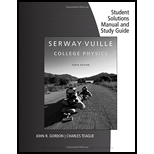
Concept explainers
A model rocket is launched straight upward with an initial speed of 50.0 m/s. It accelerates with a constant upward acceleration of 2.00 m/s2 until its engines stop at an altitude of 150. m. (a) What can you say about, the motion of the rocket alter its engines stop? (b) What is the maximum height reached by the rocket? (c) How long after liftoff does the rocket reach its maximum height? (d) How long is the rocket in the air?
(a)
Answer to Problem 53P
Explanation of Solution
The motion of the rocket can be determined using the acceleration of the rocket.
When the rocket moves upwards, then the engines forces the rocket to move upwards. When there is no external force acting on the rocket, the rocket is moving under the gravitational force. The magnitude of the acceleration acting on the rocket is the acceleration due to gravity. The acceleration due to gravity acts always downwards.
When the engine stops, the rocket starts moves under the acceleration due to gravity and which is opposite to the direction of the motion. This will slow down the rocket. As the rocket reaches its maximum height, the rocket has zero velocity. Then it falls under gravity. The acceleration and the motion of the rocket go on the same direction. This results in speeding up the rocket from zero to the maximum speed when it reaches the ground.
Conclusion:
After its engines stop, the rocket is a freely falling body under gravity. It continues upward and eventually slows under the influence of gravity. The rocket comes to rest momentarily at its maximum altitude. Then it falls back to Earth, gaining speed as it falls due to the acceleration due to gravity.
(b)
Answer to Problem 53P
Explanation of Solution
Given info: The initial velocity of the of the rocket is
Explanation:
The formula used to calculate the final velocity of the rocket when it is accelerating upwards is,
Here,
Substitute
Thus, The final velocity of the rocket when the engine stops is
The formula used to calculate the displacement of the rocket after the engine stops is,
Here,
Substitute
Thus, The displacement of the rocket after the engine stops is
The formula used to calculate the maximum height the rocket reaches is,
Here,
Substitute
Thus, the maximum height the rocket reaches is
Conclusion:
The maximum height the rocket reaches is
(c)
Answer to Problem 53P
Explanation of Solution
The formula used to calculate the interval at which the rocket moves with an upward acceleration is,
Here,
Substitute
Thus, the time interval at which the rocket has upward acceleration is
The formula used to calculate the interval at which the rocket moves upwards after the engine stops is,
Here,
Substitute
Thus, the time interval at which the rocket moves upward after the engine stops is
The formula used to calculate the total time of the upward flight is,
Here,
Substitute
Thus, the time taken by the rocket to reach the maximum height
Conclusion:
The time taken by the rocket to reach the maximum height
(d)
Answer to Problem 53P
Explanation of Solution
The formula used to calculate the total time of the downward flight is,
Here,
Substitute
Thus, the total time of the downward flight is
The formula used to calculate the total time of flight is,
Here,
Substitute
Thus, the total time the rocket stays in air
Conclusion:
The total time the rocket stays in air
Want to see more full solutions like this?
Chapter 2 Solutions
EBK STUDENT SOLUTIONS MANUAL WITH STUDY
Additional Science Textbook Solutions
Essentials of Human Anatomy & Physiology (12th Edition)
Fundamentals Of Thermodynamics
Loose Leaf For Integrated Principles Of Zoology
MARINE BIOLOGY
Biology: Life on Earth (11th Edition)
- Can someone help me with this question. Thanks.arrow_forwardIdentical rays of light enter three transparent blocks composed of different materials. Light slows down upon entering the blocks.arrow_forwardFor single-slit diffraction, calculate the first three values of (the total phase difference between rays from each edge of the slit) that produce subsidiary maxima by a) using the phasor model, b) setting dr = 0, where I is given by, I = Io (sin (10) ². 2arrow_forward
 Glencoe Physics: Principles and Problems, Student...PhysicsISBN:9780078807213Author:Paul W. ZitzewitzPublisher:Glencoe/McGraw-Hill
Glencoe Physics: Principles and Problems, Student...PhysicsISBN:9780078807213Author:Paul W. ZitzewitzPublisher:Glencoe/McGraw-Hill Principles of Physics: A Calculus-Based TextPhysicsISBN:9781133104261Author:Raymond A. Serway, John W. JewettPublisher:Cengage Learning
Principles of Physics: A Calculus-Based TextPhysicsISBN:9781133104261Author:Raymond A. Serway, John W. JewettPublisher:Cengage Learning Physics for Scientists and Engineers, Technology ...PhysicsISBN:9781305116399Author:Raymond A. Serway, John W. JewettPublisher:Cengage Learning
Physics for Scientists and Engineers, Technology ...PhysicsISBN:9781305116399Author:Raymond A. Serway, John W. JewettPublisher:Cengage Learning Classical Dynamics of Particles and SystemsPhysicsISBN:9780534408961Author:Stephen T. Thornton, Jerry B. MarionPublisher:Cengage Learning
Classical Dynamics of Particles and SystemsPhysicsISBN:9780534408961Author:Stephen T. Thornton, Jerry B. MarionPublisher:Cengage Learning Physics for Scientists and Engineers: Foundations...PhysicsISBN:9781133939146Author:Katz, Debora M.Publisher:Cengage Learning
Physics for Scientists and Engineers: Foundations...PhysicsISBN:9781133939146Author:Katz, Debora M.Publisher:Cengage Learning College PhysicsPhysicsISBN:9781938168000Author:Paul Peter Urone, Roger HinrichsPublisher:OpenStax College
College PhysicsPhysicsISBN:9781938168000Author:Paul Peter Urone, Roger HinrichsPublisher:OpenStax College





